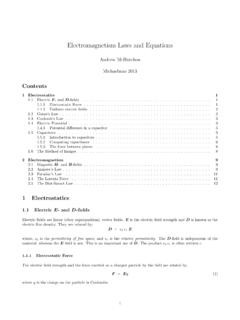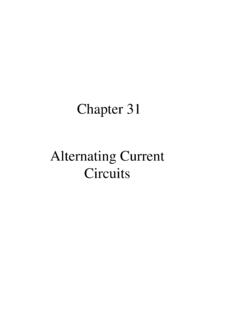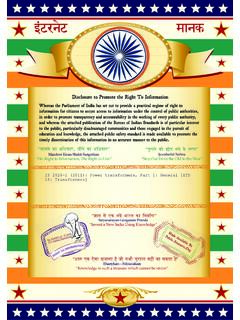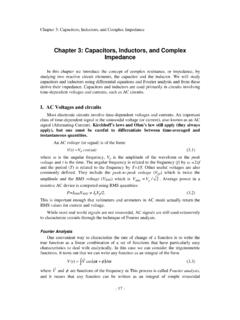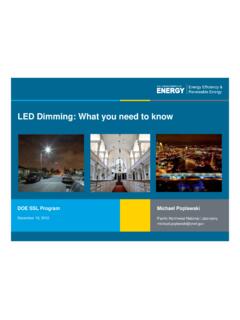Transcription of RLC Resonant Circuits - University of Cambridge
1 RLC Resonant CircuitsAndrew McHutchonApril 20, 20131 Capacitors and InductorsThere is a lot of inconsistency when it comes to dealing with reactances of complex components. The formatfollowed in this document is as follows. Theimpedance,Z, of a component or a circuit is defined as,Z=R+j X(1)whereRis the resistance,jis the imaginary unit, andXis the reactance. Note that the imaginary unit isoutsidethe reactance and there is a plus sign betweenRandj and inductors are both components which can store energy: capacitors store it in an electric field andinductors in a magnetic field. Ideal capacitors and inductors are assumed to have zero resistance and so have apurely imaginary impedance,ZC=1j C= j CZL=j L(2)Following the convention in equation 1 we define the reactances to be,XC= 1 CXL= L(3)note that the minus sign is includedinsideXC, this is to ensure we get a plus sign in equation 1. You will oftensee capacitive reactance being quoted without this minus sign - be very careful!
2 Figure 1 shows how the absolute value of the reactances of the inductor and the capacitor change with that the capacitive reactance, and hence impedance, heads towards infinity for DC currents and zero for highFigure 1: Reactance of a capacitor and a inductor angular frequency1frequency AC currents. This is what we expect - ideal capacitors are considered open Circuits for DC current andshort Circuits for high enough frequency AC signals (this is why we can ignore some capacitors in transistor circuitsat mid-band frequencies).2 Series CircuitFigure 2: Series RLC circuitFigure 2 shows a series Resonant RLC circuit. The total impedance in the circuit is given by,Ztotal=R+ZL+ZC=R+j(XL+XC)=R+j( L 1 C)(4)(5)Figure 3 shows how the total impedance changes with frequency Figure 1 shows that the absolute reactances ofFigure 3: Magnitude and phase of impedance in a series RLC circuita capacitor and inductor will approach each other and cross as frequency increases.
3 If we now recall thatXCisactually negative then it is clear thatXL+XCmust head towards zero in this frequency range. At the specificfrequency whereXL= XC, the imaginary components of the impedance exactly cancel each other out (equation4 shows this most clearly). At this frequency the impedance of the circuit has its smallest magnitude and a phase2 Figure 4: Voltage amplification over the capacitor in a series RLC circuitangle of zero (remember only imaginary components can move phase angles away from zero). This is called theresonant frequencyof the circuit,f0. It is always the frequency which causesXLandXCto cancel each otherout,XL+XC= 0 XL= XC 0L=1 0C 20=1LC 0= 1LC(6)where 0= 2 f0, the Resonant angular must be able to calculate the Resonant frequency for arbitrary RLC see the resonance effect consider the ratio of the voltage across the reactive components to the input example, for the capacitor,vCv=11 2LC+j RC(7)This ratio is plotted against angular frequency for particular values ofR,L, andCin figure 4.
4 The figure showsthat the circuit exhibits voltage amplification properties. At the Resonant frequency,vCv=1j 0 RCvLv=j 0LR(8)It is important to note that as this is a passive circuit the total amount of power dissipated is Parallel CircuitFigure 5 shows a parallel Resonant RLC circuit. It is the dual of the series circuit in that the voltage and currentexchange roles. This means that the circuit has a current gain rather than a voltage gain and that the impedance is3 Figure 5: Parallel RLC circuitmaximised at the Resonant frequency rather than minimised. The total impedance in the circuit is given by,Ztotal=R ZL ZC=R1 jR(1XC+1XL)=R1 +jR( C 1 L)(9)(10)Figure 6 shows the magnitude and phase of the impedance of the circuit. Once again the Resonant peak comeswhenXC= XLand hence the Resonant frequency is given by the same relationship, 0= 1LC(11)The current gain can be calculated by looking at the current in each of the arms.
5 Take the capacitor again,Figure 6: Magnitude and phase of impedance in a parallel RLC circuitiCi=j RC1 +jR( C 1 L)(12)The current gain magnitude is shown in figure 7. At the Resonant frequency,iCi=j RC(13)4 Figure 7: Current gain in the capacitor4 Q factorThe Quality Factor, or Q Factor, describes how under-damped a resonator is; the higher the Q factor the lessdamping there is. In an electrical resonator circuit damping is caused by the loss of energy in resistive Q factor can therefore be described as:Q( ) = Maximum Energy StoredPower Loss(14)The Q factor depends on frequency but it is most often quoted for the Resonant frequency maximum energy stored in a Resonant circuit at the Resonant frequency can be calculated from either the maxenergy stored in the capacitor or the max energy stored in the inductor - it is not the sum of these as when one isholding its max energy the other has zero energy in it.
6 The relevant equations are:Max energy stored =L I2 Lrms=C V2 Crms(15)Note thatILrmsis the rms current through the inductor. For a simple series RLC circuit such as figure 2, this isjust equal to the total rms current flowing in the circuit, however for a parallel RLC circuit this willnotbe thesame. Similarly,VCrmsis the rms voltage across the capacitor. For the simple parallel RLC circuit shown in figure5 this is just equal to the rms supply voltage but for the series RLC circuit it is given by a potential divider , for series Circuits it is in general simpler to calculate the max energy stored by considering the inductorand in parallel Circuits by considering the power is only dissipated in the resistors,P=VRrmsIRrms=I2 RrmsR=V2 RrmsR(16)For the series RLC circuit it is easiest to consider currents,Q(s) 0= 0I2rmsLI2rmsR= 0LR(17)For the parallel circuit it is simpler to consider voltages,Q(p) 0= 0RC V2 CrmsV2 Crms= 0CR(18)5 For high values of Q it is worth noting that the following definition is also mathematically accurate,Q= 0 (19)where is the circuit bandwidth, the distance between the two cut-off angular frequencies (aka the -3dBpoints).
7 5 Lossy ComponentsSo far we have assumed that the inductor and the capacitor are ideal components with no internal resistances. Inthis section we look at the effect of a more realistic model of the reactive components on the Resonant InductorsAn inductor is essentially just a coil of wire and so often has a non-negligible resistance. This is most readilymodelled as a resistor in series with the inductor as shown on the left in figure 8. The smaller this resistance is themore ideal the inductor 8: Series and parallel internal resistance for an inductorWe can define a Q factor for just the inductor and its internal resistance in the same way as we did for the wholecircuit in the previous section. In fact the derivations are the same meaning,Q(s)L=X(s)LR(s)(20)We could also define an equivalent circuit with a parallel resistance, as in the circuit on the right of figure 8. Wecan calculate the Q factor for this circuit using the same method, noting that,I(p)Lrms=Vrms L(p)I(p)Rrms=VrmsR(p)(21)which leads to,Q(p)L=R(p)X(p)L(22)For the two Circuits in figure 8 to be equivalent their impedances must be equal.
8 This also implies that their Qfactors must also be equal,Q(s)L=Q(p)L(23)X(s)LR(s)=R(p)X(p)L (24),QL(25)6If we equate imaginary parts of the impedances of the two Circuits and substitute inR(p)L=QLX(p)L, we getX(p)L=X(s)L(1 +Q 2L)(26)Thus for large Q we can effect an approximation,X(p)L X(s)L(27)R(p)LXL XLR(s)L(28)This relationship is often used in the course to allow you to switch between CapacitorsIn an ideal capacitor the two plates are perfectly insulated from each other. However, in a real capacitor theinsulation comes from the dielectric between the two plates which has a finite resistance. This allows a smallcurrent to flow between the two plates. A non-ideal capacitor is therefore modelled as an ideal capacitor in parallelwith a resistor, similar to the setup in the right circuit of figure 8. The larger this resistor is the closer to ideal thecapacitor with an inductor we can define a Q factor for the capacitor,QC=R(p)X(p)C(29)The analysis is analogous to the inductor, thus for large Q we can write,R(p)CXC XCR(s)C(30)7

